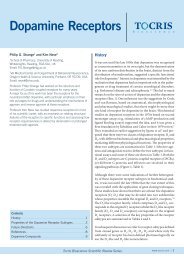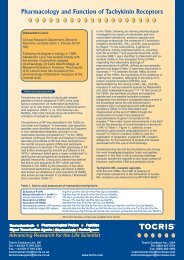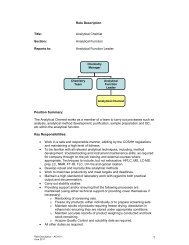5-HT Receptors and their Ligands
5-HT Receptors and their Ligands
5-HT Receptors and their Ligands
You also want an ePaper? Increase the reach of your titles
YUMPU automatically turns print PDFs into web optimized ePapers that Google loves.
gene (Fos protein) expression in nociceptive<br />
neurones in the rat brainstem.<br />
61<br />
Further<br />
selective lig<strong>and</strong>s are currently in development,<br />
i.e. LY 344864 <strong>and</strong> BRL 54443 (Figure 2).<br />
However, these also have affinity for 5-ht1E<br />
receptors.<br />
62,63<br />
The 5-<strong>HT</strong> receptor class<br />
2<br />
The 5-<strong>HT</strong>2<br />
receptor class is comprised of the<br />
5-<strong>HT</strong> 2A, 5-<strong>HT</strong>2B <strong>and</strong> 5-<strong>HT</strong>2C<br />
receptor subtypes,<br />
which exhibit 46-50% overall sequence identity<br />
<strong>and</strong> couple preferentially to Gq/11<br />
to increase the<br />
hydrolysis of inositol phosphates <strong>and</strong> elevate<br />
cytosolic Ca 2+ . The binding affinity of various<br />
5-<strong>HT</strong> lig<strong>and</strong>s at 5-<strong>HT</strong>2<br />
receptor subtypes is<br />
summarised in Table 4.<br />
5-<strong>HT</strong>2A<br />
receptors<br />
The 5-<strong>HT</strong>2A<br />
receptor contains 471 amino acids<br />
in rats, mice <strong>and</strong> humans <strong>and</strong> is widely<br />
distributed in peripheral <strong>and</strong> central tissues.<br />
5-<strong>HT</strong>2A<br />
receptors mediate contractile responses<br />
in a series of vascular smooth muscle<br />
preparations. In addition, platelet aggregation<br />
<strong>and</strong> increased capillary permeability following<br />
exposure to 5-<strong>HT</strong> have been attributed to<br />
5-<strong>HT</strong>2A<br />
receptor-mediated functions. Centrally,<br />
these receptors are principally located in the<br />
cortex, claustrum <strong>and</strong> basal ganglia. Activation<br />
of 5-<strong>HT</strong>2A<br />
receptors stimulates hormone<br />
secretion, e.g. ACTH, corticosterone, oxytocin,<br />
renin <strong>and</strong> prolactin.<br />
64<br />
5-<strong>HT</strong>2A<br />
receptor agonists<br />
mediate certain behavioural syndromes in vivo.<br />
Head twitching in mice, <strong>and</strong> wetdog shakes <strong>and</strong><br />
back muscle contractions in rats, can be<br />
inhibited with 5-<strong>HT</strong> receptor antagonists with a<br />
2<br />
Table 4. Affinity (pK i) of various lig<strong>and</strong>s for<br />
5-<strong>HT</strong> receptor subtypes<br />
2<br />
5-<strong>HT</strong> 5-<strong>HT</strong> 5-<strong>HT</strong><br />
2A 2B 2C<br />
5-<strong>HT</strong>2A<br />
receptor<br />
Spiperone<br />
8.8 5.5 5.9<br />
MDL 100907 9.4 nd 6.9<br />
Ketanserin<br />
8.9 5.4 7.0<br />
5-<strong>HT</strong>2B<br />
receptor<br />
5-MeOT 7.4a<br />
8.8a<br />
6.2a<br />
-Methyl-5-<strong>HT</strong><br />
SB 204741<br />
BW 723C86<br />
6.1a < 5.3<br />
< 5.4a<br />
8.4a 7.8<br />
7.9<br />
a<br />
7.3a<br />
< 6.0<br />
< 6.9<br />
5-<strong>HT</strong>2C<br />
receptor<br />
SB 242084 6.8 7.0 9.0<br />
RS 102221<br />
Ro 60-0175<br />
6.0<br />
6.0<br />
6.1<br />
5.8<br />
8.4<br />
8.8<br />
5-<strong>HT</strong>2B/2C<br />
receptors<br />
SB 200646A<br />
5.2 7.5 6.9<br />
mCPP 6.7 7.4a<br />
7.8<br />
SB 206553<br />
Non-selective<br />
LY 53857<br />
5.8<br />
7.3<br />
8.9<br />
8.2<br />
7.9<br />
8.1<br />
ICI 170809 9.1 nd 8.3<br />
Ritanserin 8.8 8.3 8.9<br />
Mianserin<br />
8.1 7.3 8.0<br />
DOI 7.3a 7.4a 7.8a<br />
(Bold text denotes compounds available from Tocris)<br />
apEC50<br />
value for agonist; nd = not determined.<br />
Taken from Barnes <strong>and</strong> Sharp (1999) Neuropharmacology<br />
30 1104. 165<br />
Figure 3. Structures of some 5-<strong>HT</strong>2<br />
receptor<br />
lig<strong>and</strong>s<br />
Ketanserin tartrate (Cat. No. 0908)<br />
SB 206553 hydrochloride<br />
(Cat. No. 1661)<br />
potency correlating with <strong>their</strong> affinity for 5-<strong>HT</strong>2A<br />
receptor binding sites. In confirmation, such<br />
head twitching has been demonstrated to be<br />
inhibited by the selective 5-<strong>HT</strong>2A<br />
receptor<br />
antagonist MDL 100907.<br />
65-67<br />
The production of<br />
drug discriminative stimulus properties of 5-<strong>HT</strong><br />
receptor agonists, e.g. (-)-2,5,-dimethoxy-4-<br />
methamphetamine (DOM) can be blocked by<br />
5-<strong>HT</strong>2<br />
receptor antagonists, such as ketanserin<br />
(Figure 3), suggesting that the discriminative<br />
cue is 5-<strong>HT</strong> receptor-mediated.<br />
68,69<br />
2A<br />
BW 723C86 hydrochloride<br />
(Cat. No. 1059)<br />
SB 204741 (Cat. No. 1372)<br />
RS 102221 hydrochloride (Cat. No. 1050)<br />
(Bold text denotes compounds available from Tocris)<br />
The most selective agents, in terms of 5-<strong>HT</strong>2A<br />
receptor affinity, are ketanserin <strong>and</strong> MDL<br />
100907. The former agent was developed for<br />
the treatment of hypertension, but it remains to<br />
be established whether 5-<strong>HT</strong>2A<br />
receptor<br />
antagonism is a valid antihypertensive principle,<br />
since ketanserin is also an 1-adrenoceptor<br />
antagonist. 5-<strong>HT</strong>2A<br />
receptor antagonists, such<br />
as risperidone, ritanserin, seroquel, olanzapine<br />
<strong>and</strong> MDL 100907, demonstrate divergent<br />
selectivity <strong>and</strong> have been indicated/developed<br />
for the treatment of schizophrenia. Inverse<br />
agonist activity for most of these compounds<br />
has been found at both 5-<strong>HT</strong>2A<br />
<strong>and</strong> 5-<strong>HT</strong>2C<br />
receptors. Therefore, this receptor-mediated<br />
inverse agonist activity seems to be a common<br />
feature for antipsychotic drugs.<br />
70<br />
However, it is<br />
not clear at the present time what the benefit<br />
would be of a silent neutral antagonist instead of<br />
an inverse agonist at these receptor subtypes.<br />
In any case, it appears that truly silent, neutral<br />
antagonists are much more uncommon than we<br />
would have previously speculated.<br />
2<br />
Development of MDL 100907 for acute<br />
schizophrenia was terminated, apparently due to<br />
insufficient efficacy; although other similar<br />
molecules are still in the pipeline. Selective<br />
2<br />
5







